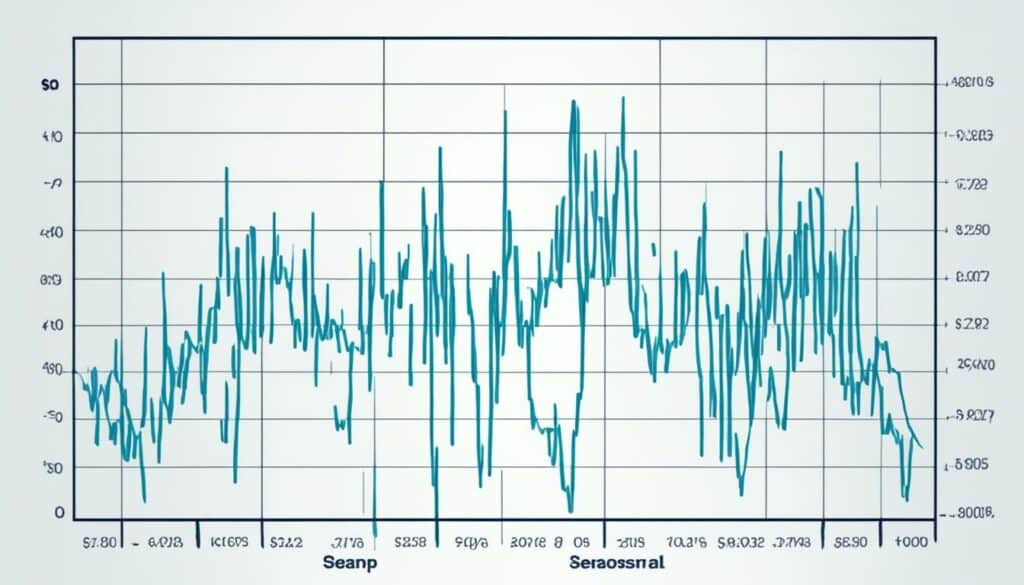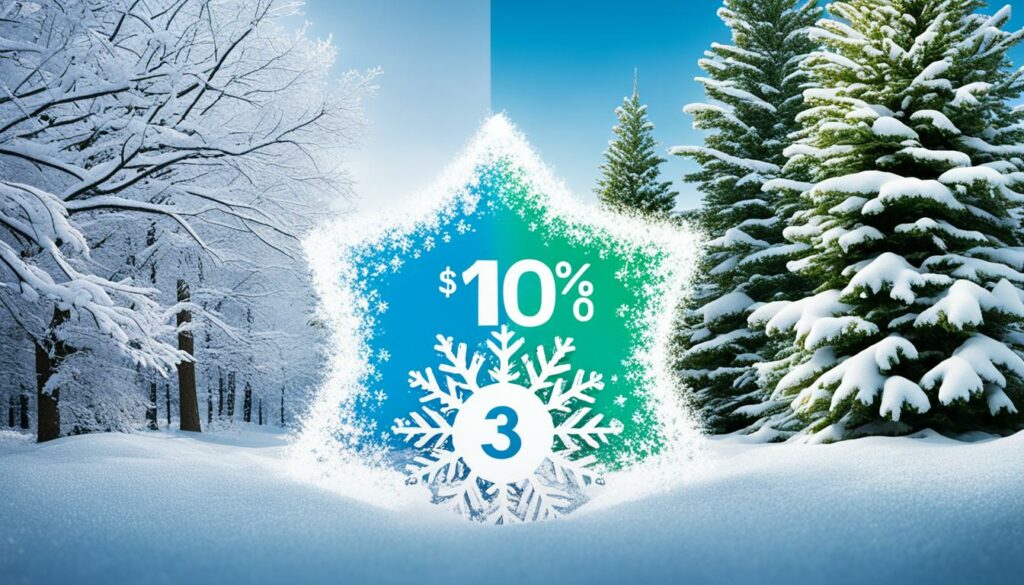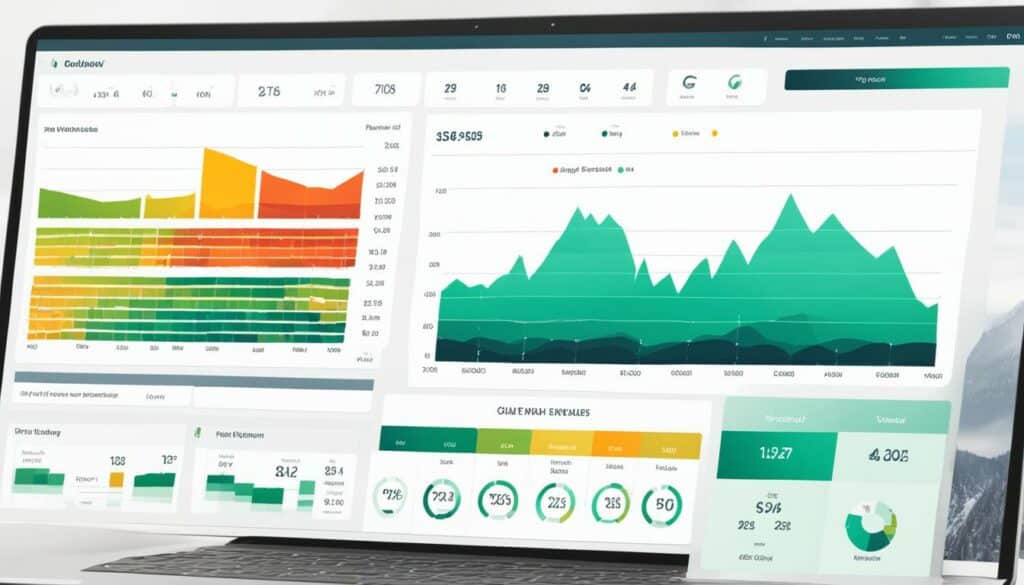Menu

Two-thirds of the U.S. GDP comes from what people spend. That makes it crucial to grasp how prices change with the seasons. When the holiday season comes around, retail sales hit their highest. This forces online giants like Amazon to take on around 100,000 extra staff. Target, a popular retailer, also hires up to 120,000 temp workers for the rush. These moves show how vital it is for companies to adjust their prices to match the changes in demand. It helps them keep their sales steady and make the most money.
If you notice prices going up or down with the seasons, you’re seeing seasonal price fluctuations in action. These changes are all about matching the prices of products or services with when people want them the most. This can affect how much money a business brings in, the number of staff they need, and when employees work. To stay ahead, businesses use smart pricing plans. By charging more or less based on when things are popular, they make extra money, keep their finances steady, and draw in new customers. They’re able to roll with the punches when the market changes, too.
Seasonal pricing trends are key for businesses, especially in areas where people spend a lot. Roughly two-thirds of the U.S. economy is from what people spend. This is strongly linked to different times of the year. Knowing about price volatility analysis helps companies make more money.
Industries that depend on seasons, like retail, make most of their money at certain times. For example, U.S. shops sell a lot more in the holiday season, especially in the last part of the year. Places like Amazon and Target hire extra staff then. In 2018, Amazon took on about 100,000 extra workers, while Target employed 120,000. They do this to handle the big rise in customer buying.
Economists adjust their studies for seasons and events like weather and holidays. They use methods like the Seasonally Adjusted Annual Rate (SAAR) to see the real economic trends better. This helps businesses guess what customers will want and plan how much to stock, staff, and advertise.
Also, some well-known effects in the stock market can change over the year. For example, in January, small company stocks often do better than big ones. But, October can be a bad month for stocks. From November to April, the S&P 500 usually sees good gains. Meanwhile, from May to October, the gains are smaller. Knowing these patterns through price volatility analysis can help businesses profit more.
For businesses to stand out, understanding seasonality and its effect on prices is critical. This includes knowing what clients like and making seasonal changes in marketing. By grasping price changes over time, companies can better match high customer needs without losing due to leftover stock. Changes in customer habits caused by climate change and culture trends mean prices need to adjust all the time.
Seasonal pricing is when businesses change their prices during different times of the year. It is very important for many fields like travel, tourism, and retail. Knowing how to adjust prices helps companies deal with changes in demand. They can make more money by doing this.

Seasonal pricing means that items or services cost more when they’re in high demand, and less when they’re not. For example, hotels in ski resorts might charge more in winter. This is when many people want to visit.
The goal is to make the most money when demand is high. Yet, businesses also want to sell more when demand is low. Doing this helps them stay busy all year.
There are two main factors in seasonal pricing: supply and demand. When more people want something, businesses can charge more. During quiet times, they may lower their prices to bring in customers.
Imagine a gardening service that offers a discount for booking in autumn. This encourages people to book before their busy season starts.
This strategy has several good points. It helps businesses make more money when demand is high. They can also spread their profit throughout the year and beat the competition.
Offering lower prices at less busy times can also bring in new customers. This keeps them coming back, improving the business’s reputation.
Making a strong seasonal pricing plan involves studying what customers do. It means choosing the best times to change prices and how much to change them. Successful businesses keep an eye on these changes and adjust when needed.
When we talk about seasonality’s economic effects, we must look at cycles and effects differently. Seasonality means changes we expect yearly. But, cyclical effects happen over various periods, depending on the economy’s wider shifts.
We see seasonal patterns a lot in what people buy, which is big for the U.S. economy. For example, retail sales increase a lot from October to December. At this time, companies like Amazon and Target hire many temporary staff to meet the demand.
“Adjusting data using tools such as the Seasonally Adjusted Annual Rate (SAAR) helps to remove seasonal variations in data, enabling more accurate comparisons between different time periods, which is particularly relevant in real estate sales.”
High-growth firms create a lot of jobs and sales in various sectors. But, lots of tourists can sometimes hurt economic growth and how well an area can recover from challenges. Businesses in tourism often earn little and their investments pay off slowly. This means they grow slower than other kinds of businesses. Take Croatia for example, its tourism industry struggles to create more high-growth firms because tourism has high and low seasons.
Seasonal industries include farming and skiing. These industries have their busy and quiet times every year. For example, lobstering has its peak between July and fall, and then slows down in late fall and winter. They have to plan their stock and staff carefully because of this. By understanding such cycles, companies can make better plans to deal with these slow and busy seasons.
To sum up, seasonality greatly affects many parts of the economy. It pushes companies to make big changes in how they work and in their financial planning. Considering seasonal changes helps in making financial and economic models that are more accurate.
Various sectors feel the impact of seasonal price changes, especially those with clear shifts in demand and supply. This includes retail, travel and tourism, and agriculture. They all need to adjust their pricing to make the most money when demand is high. They also work hard to keep sales going during slow times.

The retail business changes a lot with the seasons, especially during holidays and special events. In the U.S, holiday spending in 2021 was around $886.7 billion. Businesses can make more money by changing product prices for high and low seasons. A good number of people plan to spend a lot during holiday shopping. Ecommerce especially gets a big boost during this time, when many Americans do most of their shopping.
The travel industry also sees big changes in prices from season to season. They might offer deals during slow times to get more customers. For example, airlines and hotels often change their prices depending on when more tourists are expected. It’s important for them to look back at how sales were before. This helps them guess when they’ll need to lower or raise their prices.
Agriculture is very much about the seasons, which affects both what gets produced and what people buy. They have to be smart about setting prices based on what the market is like and what’s happened before. If they’re selling a lot, they need to make sure they can deliver by keeping their stock full. Using a company like ShipBob can help with this. Their tools predict how much stuff will sell based on what we’ve seen before. This means businesses can be ready for whatever customers need.
| Industry | Key Seasonal Effects | Strategies Utilised |
|---|---|---|
| Retail | Holiday spending spikes | Adjusting prices, increasing inventory |
| Travel and Tourism | High during holidays, low during off-season | Discounts during low-demand, peak pricing |
| Agriculture | Seasonal crop yields | Order volume adjustments, third-party logistics |
Each industry uses its own way to handle prices changing through the year. They study and guess what will happen next, so they can stay in the game. This is true for sellers, travel spots, and food producers.
Analysing seasonal price trends means collecting and using the right data. This helps spot patterns. Knowing these can boost your profits and make your business run smoother.
Great analysis starts with getting sales history, what customers do, and market movements. Things like time series analysis and SAAR can show true trends. They take out the small changes you don’t need to worry about. The extra sales in the holidays, for example, might hide the real trends.
Using smart tools like regression and moving averages can unlock hidden trends. This helps you guess better and plan smarter.
Seeing the big trends in prices needs a deep look at sales history. You might notice prices going up or down at certain times. For example, retail shops hire more people when they know they’ll be busier. Or farmers might lower prices when they have a lot to sell.
Knowing when prices might change helps your business get ready. This is about more than just prices. It’s also about managing your money well. Think of hotels by the beach. They charge more in summer when everyone wants to come. In winter, they offer deals to keep people booking. A gardening company does the same, adjusting discounts based on when they’re needed most.
| Season | Industry | Pattern | Strategy |
|---|---|---|---|
| Winter | Natural Gas | Price Increase due to Heating Demand | Adjust Prices to Peak Demand |
| Summer | Electricity | Price Spike due to Cooling Demand | Implement Higher Rates Amid Increased Usage |
| Fourth Quarter | Retail | Sales Surge during Holiday Season | Hire Additional Staff, Increase Inventory |
| Harvest Season | Agriculture | Price Drop due to Supply Influx | Maximise Sales with Competitive Pricing |
Also, using tools to show data like box plots can make these patterns clearer. This helps with planning and making smart decisions.
Creating good seasonal pricing plans is key for any business. It helps manage profits and stay competitive. To do this, you need to know what the market and customers want. This way, you can price your products just right, meeting both value and demand.
Knowing your market and customers inside out is crucial. Look at when customers buy more to find seasonal pricing chances. Also, talk to customers directly. Surveys can reveal why they buy in different seasons. This info is gold for setting prices that work.
Demand varies over the year. Some times, like holidays, see a lot of buying. Others, like the colder months, can be quieter. For example, travel is big during holidays, but gardening is more popular in warmer months. Spot these trends to price things right.

First, decide your standard price. Then, adjust it for seasonal pricing. Charge more when demand is high to boost profits. Cut prices in slow months to draw in budget-conscious buyers. This approach keeps income steady all year round.
It’s crucial to keep an eye on how your prices are doing. Watch sales, new customers, and profits over the year. If something’s not working, make changes. This keeps your pricing smart and adapts to what customers want. Staying alert helps you steer through market changes wisely.
Using seasonal prices can really help businesses make more money. But there are many challenges. One big issue is that customers often wait for discounts. This can mess up the usual way of buying things and make companies feel they have to lower their prices. This can make the services seem not as valuable and lower how much money the company makes.
One big problem with seasonal pricing is getting your supply and demand mixed up. You might have too much or too little stock which means you waste money and miss chances to sell more. Looking at past data and using computers to guess future trends can help. They can tell you when to expect more people to buy.
Also, not pricing things right at different times of the year can confuse customers. They should see fair price changes at various times. If they don’t, they might not trust the business as much. And companies can focus too much on their base prices. This means they might forget about making money in other ways.

To deal with these problems, businesses can do a few things. First, they should look at the market and check out what their competitors are doing. This helps them set prices that are good for the customers but still make the business money. There are special tools like Little Hotelier Insights that help check on competitors’ prices in real-time.
Also, it’s very important to guess how much customers will buy accurately. Using information from past sales can help with this. It lets businesses prepare better for when lots of people might want to buy. Getting help from companies that handle deliveries, like ShipBob, can make sure everything runs smoothly. This helps keep customers happy and the business working well.
Staying on top of how the pricing strategy is going is the last step. This means checking different numbers regularly, like how much money each room or service makes. By doing this, businesses can change their prices as needed to make more money and stay competitive.
It’s key for companies to understand consumer behaviour to set the right seasonal prices. They can change prices to match what people want in different seasons. This way, businesses can sell more and make the most money all year round.
Changing prices by season can really change how much customers buy. Think about landscaping businesses. They might give discounts for prepayments, like 10% off in autumn. This gets customers to buy early, bringing in money even when business is slow.
But, there’s a catch. Some customers might hold off buying until things are cheaper. This could briefly lower sales. Knowing these details helps businesses set prices smartly and keep their regulars happy.
Adjusting prices by season can win over customers for the long haul. This boosts sales for now and builds lasting customer relationships. Sectors like travel and retail use this strategy well. They make sure there’s value for customers all year. This keeps money flowing and customers coming back, no matter the season.
It’s crucial for businesses to constantly check how their pricing strategies are doing. By keeping an eye on what drives customer interest, they can tweak their plans. This careful balance can keep profits high and customers happy.
Looking at real-world prices over seasons helps us understand what works. We’ll look at what made some strategies a hit, while others missed the mark. This insight shows how pricing at the right time can really make a difference.
The Sniffie app on Shopify stands out as a win. It used AI to set prices that earned more money, even while dropping prices. This approach made Shopify stores more attractive and brought in more shoppers.
The travel and leisure sector has also done well with this approach. They change their prices as demand goes up or down. By doing this, they fill more rooms and seats, making more money without lowering their average prices.
Retailers shine during holiday sales, like Black Friday. They see a big jump in sales as they offer time-limited deals. This strategy works because it makes customers buy before the deal ends, boosting the overall sales.

But, not everyone gets it right. Some businesses have flopped with seasonal pricing because they didn’t check feedback or sales data. This info is key to setting the right prices and avoiding stockpile costs.
Others, like farms, saw prices fall because they didn’t predict crop amounts well. They lost money when crops were plenty. Good planning avoids these pitfalls.
Lastly, some just missed the right time to get ready. They didn’t make their shops look festive or their prices attractive. Sales were lost because they weren’t ready for key shopping times.
Here, we outline what worked and what didn’t:
| Successful Approaches | Unsuccessful Approaches |
|---|---|
| Identifying key seasonal events | Ignoring the importance of seasonal planning |
| Offering limited-time discounts and promotions | Failing to adjust prices according to demand |
| Utilising AI for real-time pricing adjustments | Lack of data analytics and forecasting |
| Bundled deals and free shipping promotions | Static pricing in dynamic market |
We learn a lot from both victories and blunders. Staying on top of your strategy is vital. It helps you sell better by meeting what your customers want, when they want it.
Seasonal prices change a lot based on the weather in that part of the world. It’s interesting to see how businesses in cold and warm places do different things with their prices. To set good pricing strategies for each region, you need to know a lot about the climate there. This part looks at how businesses use the weather to set their prices.
In cold places, like Minnesota, winter can be tough for sales. So, they cut prices to get more buyers and keep money coming in. But when summer comes, home prices go up because people are keen to buy. This shows how the weather changes the prices of things.
However, places like Florida or California are different. Their winter is a busy time due to tourism. Businesses can then charge more because more visitors are around. This difference in how prices change through the seasons shows the need to adapt prices to the climate.
| Region | Peak Seasons | Off-Peak Seasons | Pricing Adjustments |
|---|---|---|---|
| Cold Climates | May-August | January-March, September-December | Higher Prices During Peak, Discounts in Off-Peak |
| Warm Climates | November-March | June-August | Increased Prices During Peak, Stable or Slight Declines in Off-Peak |
Changing prices based on the local weather is key to making more money. In farming, for example, the prices of sow and pig variations are noticed. For instance, corn changes affect the prices of 40-pound pigs from March to September. This means prices must change too, especially in colder areas where these pigs are wanted more at different times.
Housing markets also have their own time for sales. For a fast sale in the U.S., March is usually best. But for the highest price, try selling in July, especially where winters are mild. These details show that to succeed in setting prices, you must think about the weather.
Advanced pricing technology has changed how companies deal with seasonal pricing. They use smart software, analytics, and machine learning to predict seasonal trends. This helps them set prices to gain more revenue.

PriceLabs Dynamic Pricing is one example of a tool that helps companies adjust prices in real time. It bases rates on current demand and supply, so companies can stay competitive.
| Feature | Description | Example Tool |
|---|---|---|
| Market Analysis | Conducting research to identify peak demand periods using pricing patterns | PriceLabs Market Dashboard |
| Dynamic Pricing Implementation | Adjusting rates based on demand and supply fluctuations | PriceLabs Dynamic Pricing |
| Competitive Pricing | Setting rates aligned with property value and amenities | PriceLabs Competitive Analysis |
| Minimum Stay Requirements | Adjusting longer minimum stay requirements during high seasons | PriceLabs MinStay Recommendations |
Analytics tools and machine learning models offer detailed market insights. They help companies understand fluctuating demands. For example, the PriceLabs Market Dashboard gives precise advice for attracting customers during off-peak times.
By using cutting-edge technology and smart analysis, businesses can create effective pricing strategies. These strategies make companies more competitive and profitable, especially in changing seasonal markets.
Seasonality is key in the real estate market. It shapes when prices go up or down. This knowledge helps buyers and sellers to make wise choices.
Property prices are greatly influenced by the time of year. In the US, June, July, and August are peak sale months. This high demand often means higher prices.
Conversely, home buying slows down in October and December. This can lead to lower prices. It’s a good time for buyers to look for bargains.
March is a great time to sell quickly. But if you want to make the most money, aim for July. Prices can vary up to 10% because of these seasonal trends.
Each area has its unique seasonal factors. Phoenix and Denver are good examples. Phoenix’s market is shaped by the weather and snowbirds influx, but Denver slows down in the cold.
Knowing these trends helps investors adjust their portfolios. The peak sales months see about 2.1 million houses sold in the US. This time represents 40% of all sales.
Buying homes when prices are low, usually in the off-peak seasons, can lead to big gains. The Midwest often sees more activity during peak times than other regions. This suggests it might be a better investment location.
Recognising the slow periods is important too, typically from November to February. The Northeast, for example, sells half as many houses in these months compared to peak months. It’s a signal for investors to be cautious.
Following these strategies can improve an investor’s gains. It involves buying smart when prices are down and selling when they’re high. This smart way of adjusting portfolios ensures a better use of resources in the property market.
Seasonal price changes greatly affect stock markets. Certain stocks and sectors do better at certain times of the year. For example, small-cap stocks often do well in January. This happens because of tax loss selling at the year’s end. After this, more people start buying in January.
“Sell in May and go away” is an important stock rule. It means selling your stocks in May and buying new ones in November. This takes advantage of the market’s cycle. Stocks tend to do worse from May to October and better from November to April. During these months, the S&P 500 can show a big difference in returns.

The October Effect is another thing we notice in the stock market. Stock prices tend to be more up and down and can drop a bit in October. One reason could be because of past market drops in this month. On the flip side, we get the Santa Claus Rally. This rally happens when stock prices start rising in late December and early January, thanks to holiday spending and hopeful investors.
Economic cycles, the way investors act, and what big companies do can all drive these patterns. For example, during summer, the market might slow down. This is because many major investors are on holiday. We call this slowdown the “Summer Doldrums.”
The end-of-quarter effect further highlights heightened volatility due to large funds rebalancing their portfolios. This can be a critical period for investors to keep an eye on market movements.
These seasonal changes also affect things like heating oil, natural gas, and crops. They differ in demand due to changing weather and farming seasons. Beef prices vary too. They’re lowest in November and go up from March to May.
| Season | Stock Performance | Commodities Affected | Key Factors |
|---|---|---|---|
| January | Small-cap stocks usually outperform | None specific | Year-end tax loss selling |
| May-October | Underperformance with 1.5% average return | Natural gas, heating oil | Institutional behaviour, vacations |
| November-April | Outperformance with 7.5% average return | None specific | Market optimism, economic cycles |
| December-January | Santa Claus Rally in stocks | Agricultural products | Holiday spending, investor sentiment |
Learning about stock market seasons helps investors make good choices. Knowing these patterns can make you a better investor. This way, you might make more money in the financial markets.
Understanding seasonal price changes is crucial for businesses that want to make more money and remain stable. By looking closely at when people buy more and adjusting prices, companies can earn more. They can change their prices smartly, making the most during busy times and lessening the loss when sales drop.
To set good seasonal prices, companies need to know the right price points. They must keep prices attractive without losing money or scaring off customers. Looking at past sales helps in choosing when to change prices, so companies can guess what shoppers will do. Offering special deals like during holidays can also boost sales even when things are usually slow.
Starting with a competitive base price after studying the market is key to changing prices well. Companies using methods like changing prices in real time or by location can do very well. But they must keep an eye on what shoppers like and stay ahead to offer the best deals. Doing this right means selling more in every season, which is essential for long-lasting success in the business world.
Seasonal price fluctuations mean that goods or services change in price with the seasons. This affects a business in many ways, like managing cash and staff numbers.
Changing prices per season can help businesses meet demand and make more money. It makes cash flow smoother and improves their chances in the market.
Seasonal pricing is about varying a product’s cost according to the time of year. This is done based on when demand is at its highest or lowest. It helps businesses run better and make more.
Seasonality happens every year at the same time, like summer or winter. Cyclical effects, however, can change within and between years due to economic trends.
Businesses in retail, travel, agriculture, and food are hit hard by seasonal price changes. They have to plan ahead to deal with these shifts.
To understand and predict price changes over time, businesses watch past sales and study customer habits. They also look at the market to see what’s coming up.
Crafting good seasonal pricing plans means knowing the market and when your products are most looked for. It involves setting prices smartly and keeping an eye on how things are going to adjust as needed.
Seasonal pricing’s downsides can include training customers to only buy on sale or to bargain. This can hurt sales regularly. To avoid this, companies need to plan carefully and keep up with their strategy.
What and when people buy changes with prices. By knowing how this works, companies can price in a way that boosts sales and keeps customers coming back.
Success stories in seasonal pricing show the power of a well-thought strategy. They share good ideas and tactics for handling demand changes.
The weather’s effect on pricing plans changes with the region. Businesses adjust to meet local needs and market trends, ensuring they don’t miss out.
Today, software, data tools, and machine learning are key in guessing seasonal trends and setting the right prices. They help businesses stay competitive.
Property prices changing with the seasons guide investors when to buy or sell. This makes for smarter investment moves and better outcomes.
Stock market performance shifts with the seasons, favouring certain sectors at different times. Knowing this can help investors make better money.